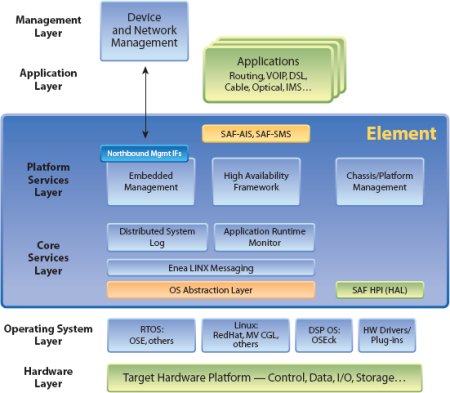Linux IPC stack adds protocol negotiation
Jun 9, 2008 — by Eric Brown — from the LinuxDevices Archive — 14 viewsEnea has upgraded its Linux-compatible interprocess communications (IPC) services software for distributed telecom systems. Linx now incorporates features that improve service availability, says Enea, including protocol/feature negotiation, priority messaging, and support for the new in-service upgrade capability in Enea's carrier-grade Element middleware.
Linx can be modified to serve as a general-purpose IPC package, but is designed primarily to enable high-speed communications between the various components of Enea's high-availability middleware stack. The Element stack's components include event logging, application monitoring, shelf management, and fault management software (see diagram below). The components sit between the carrier's service applications and multiple systems that potentially run different telecom operating systems, typically including Carrier-grade Linux distributions, and Enea's proprietary real-time operating systems OSE RTOS and OSEck RTOS (for DSPs).

Linx acts as a core services function in the Enea Element architecture
Available under commercial and open source licenses, Linx was announced in early 2006, shipped last August, and was upgraded to version 2.0 in January. According to Sweden-based Enea, Linx performs about 20 percent better than the open-source Transparent Inter Process Communication (TIPC) protocol. Enea also touts Linx's better multi-core support, greater scalability (it scales down to DSPs, and up to multi-core processors), and its “transparency” across chip, OS, and interconnect boundaries.
New in the latest release of Linux is a protocol/feature negotiation technology aimed at “future-proofing” Linx. Enea says the technology will help make future releases of Linx backward compatible with previous releases, by letting multiple instances of Linx arbitrate a set of supported protocols and features.
Another touted new feature is priority messaging, aimed at making sure that IPC is maintained to systems that have become congested due to a fault condition. Finally, the new release, which has not yet been tagged with a version number, is also designed to support new in-service upgrade features in Element 3.0, which is due this month, Enea said.
According to a statement from Terry Pearson, VP of marketing for Enea, the protocol/feature negotiation capability enables “equipment makers to take advantage of the latest Enea LINX upgrades on a node by node basis without compromising compatibility with existing Enea LINX implementations.”
Availability
Enea Linx for Linux is available now as free, open source software (BSD or GPL license) on SourceForge. The OSE versions of Enea Linx are now available for $5,000 per 10-user license, says Enea. More information on Linx may be found here.
This article was originally published on LinuxDevices.com and has been donated to the open source community by QuinStreet Inc. Please visit LinuxToday.com for up-to-date news and articles about Linux and open source.